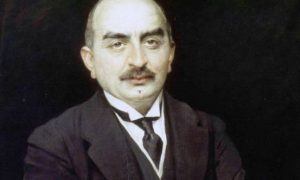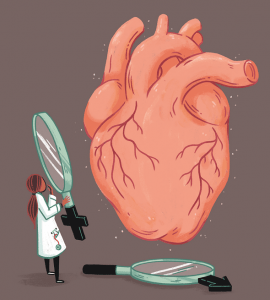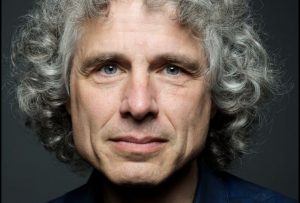Month: January 2019
Mr Five Per Cent – the world’s richest man
Oliver Bullough in The Guardian:
 What does the life of an Ottoman-born ethnic Armenian oil tycoon have to teach us about the modern world? Quite a lot, it turns out, judging by this fascinating biography of Calouste Gulbenkian, a dealmaker for the ages and, at his death in 1955, the world’s richest man. Gulbenkian saw an oilfield only once, on a visit to Baku (then an oil-fuelled boomtown in the Russian empire, now the capital of Azerbaijan) as a 19-year-old graduate from King’s College London, but he was very quick to appreciate the importance of oil as a commodity, and the opportunity inherent in international competition for it. He combined excellent contacts in the Middle East with skills he learned as an entrepreneur in the City of London, and secured a 5% stake in all oil found beneath the Asian territories of the Ottoman empire.
What does the life of an Ottoman-born ethnic Armenian oil tycoon have to teach us about the modern world? Quite a lot, it turns out, judging by this fascinating biography of Calouste Gulbenkian, a dealmaker for the ages and, at his death in 1955, the world’s richest man. Gulbenkian saw an oilfield only once, on a visit to Baku (then an oil-fuelled boomtown in the Russian empire, now the capital of Azerbaijan) as a 19-year-old graduate from King’s College London, but he was very quick to appreciate the importance of oil as a commodity, and the opportunity inherent in international competition for it. He combined excellent contacts in the Middle East with skills he learned as an entrepreneur in the City of London, and secured a 5% stake in all oil found beneath the Asian territories of the Ottoman empire.
When the deal was signed, on the eve of the first world war, his stake didn’t sound like much, but he fought for decades to hang on to it and, by the 1950s, he had a shilling for every pound earned from some of the world’s richest oilfields. And that really added up. In modern terms, he died with a fortune of almost £5bn. He was clearly not an easy person to like, and fell out with almost everyone he came across, but his buccaneering qualities make him an extremely interesting person to read about. At one point, he exploited the young Soviet Union’s shortage of capital to build the nucleus of a world-class art collection. There are several Rembrandts missing from the Hermitage, thanks to his negotiating skills.
How ‘magic angle’ graphene is stirring up physics
Elizabeth Gibney in Nature:
 It was the closest that physicist Pablo Jarillo-Herrero had ever come to being a rock star. When he stood up in March to give a talk in Los Angeles, California, he saw scientists packed into every nook of the meeting room. The organizers of the American Physical Society conference had to stream the session to a huge adjacent space, where a standing-room-only crowd had gathered. “I knew we had something very important,” he says, “but that was pretty crazy.”
It was the closest that physicist Pablo Jarillo-Herrero had ever come to being a rock star. When he stood up in March to give a talk in Los Angeles, California, he saw scientists packed into every nook of the meeting room. The organizers of the American Physical Society conference had to stream the session to a huge adjacent space, where a standing-room-only crowd had gathered. “I knew we had something very important,” he says, “but that was pretty crazy.”
The throngs of physicists had come to hear how Jarillo-Herrero’s team at the Massachusetts Institute of Technology (MIT) in Cambridge had unearthed exotic behaviour in single-atom-thick layers of carbon, known as graphene. Researchers already knew that this wonder material can conduct electricity at ultra-high speed. But the MIT team had taken a giant leap by turning graphene into a superconductor: a material that allows electricity to flow without resistance. They achieved that feat by placing one sheet of graphene over another, rotating the other sheet to a special orientation, or ‘magic angle’, and cooling the ensemble to a fraction of a degree above absolute zero. That twist radically changed the bilayer’s properties — turning it first into an insulator and then, with the application of a stronger electric field, into a superconductor. Graphene had previously been cajoled into this behaviour by combining it with materials that were already known to be superconductors, or by chemically splicing it with other elements. This newfound ability to induce the same properties at the flick of a switch turned heads. “Now you put two, non-superconducting atomic layers together in a certain way and superconductivity pops up? I think that took everyone by surprise,” says ChunNing Jeanie Lau, a physicist at the Ohio State University in Columbus.
More here.
Thursday Poem
in puerto rico we inherit your wars
maldita sea we fight them and what did you give us
under the church in mayagüez there are taíno bones
the father knows it
all the fathers
he said take this ribbon and measure the church dimensions
tell me if it’s worth
destroying faith for some bones
what i saw when i walked around with my ribbon
were old women praying to papito dios
with tears of faith for his creatures
malformed by desire
airs of bettering what isn’t enough
i saw the faces of saints some sweet and others
as arbitrary as abstinence
more than anything i saw the gold the cruelty
i went back to the father after covering the church
with the ribbon the scene of a crime
and bendito i didn’t ask for forgiveness
nor could i explain
the newfound hate
by Raquel Salas Rivera
from Poems for the Nation
Bilingual press, 2018
It’s All Over
Justin E. H. Smith in his own blog:
 Is there any way to intervene usefully or meaningfully in public debate, in what the extremely online Twitter users are with gleeful irony calling the ‘discourse’ of the present moment?
Is there any way to intervene usefully or meaningfully in public debate, in what the extremely online Twitter users are with gleeful irony calling the ‘discourse’ of the present moment?
It has come to seem to me recently that this present moment must be to language something like what the industrial revolution was to textiles. A writer who works on the old system of production can spend days crafting a sentence, putting what feels like a worthy idea into language, only to find, once finished, that the internet has already produced countless sentences that are more or less just like it, even if these lack the same artisanal origin story that we imagine gives writing its soul. There is, it seems to me, no more place for writers and thinkers in our future than, since the 19th century, there has been for weavers.
This predicament is not confined to politics, and in fact engulfs all domains of human social existence. But it perhaps crystallises most refractively in the case of politics, so we may as well start there.
There are memes circulating that are known as ‘bingo cards’, in which each square is filled with a typical statement or trait of a person who belongs to a given constituency, a mouth-breathing mom’s-basement-dwelling Reddit-using Mens’s Rights Activist, for example, or, say, an unctuous white male ally of POC feminism. The idea is that within this grid there is an exhaustive and as it were a priori tabulation, deduced like Kant’s categories of the understanding, of all the possible moves a member of one of these groups might make, and whenever the poor sap tries to state his considered view, his opponent need only pull out the table and point to the corresponding box, thus revealing to him that it is not actually a considered view at all, but only an algorithmically predictable bit of output from the particular program he is running. The sap is sapped of his subjectivity, of his belief that he, properly speaking, has views at all.
More here.
Yes, there is a war between science and religion
Jerry Coyne in The Conversation:
 As the West becomes more and more secular, and the discoveries of evolutionary biology and cosmology shrink the boundaries of faith, the claims that science and religion are compatible grow louder. If you’re a believer who doesn’t want to seem anti-science, what can you do? You must argue that your faith – or any faith – is perfectly compatible with science.
As the West becomes more and more secular, and the discoveries of evolutionary biology and cosmology shrink the boundaries of faith, the claims that science and religion are compatible grow louder. If you’re a believer who doesn’t want to seem anti-science, what can you do? You must argue that your faith – or any faith – is perfectly compatible with science.
And so one sees claim after claim from believers, religious scientists, prestigious science organizations and even atheists asserting not only that science and religion are compatible, but also that they can actually help each other. This claim is called “accommodationism.”
But I argue that this is misguided: that science and religion are not only in conflict – even at “war” – but also represent incompatible ways of viewing the world.
More here.
The Many Lives of Liberalism
David A. Bell in the New York Review of Books:

While the collapse of communism did not bring history to an end, it did, briefly, seem to establish a worldwide consensus of sorts. Had one particular social and political system, by dint of hard experience, proven superior to all its rivals? Apparently yes. That system was what could be called the liberal ideal, constructed around representative democracy, human rights, and free-market capitalism complemented by a strong social safety net. If this system did not turn out to be the inevitable, placid, posthistorical future of all mankind, as predicted in Francis Fukuyama’s notorious 1989 essay, it nonetheless stood as a goal toward which all humanity was now going to strive.
That consensus seemed to hold even after the bloody disintegration of Yugoslavia and the September 11 attacks. Now, however, it is fracturing. Around the world, populist politicians on the right are winning elections by warning demagogically that representative democracy and human rights policies are too weak to protect hardworking, native-born families against threats from beyond their national borders—especially terrorists and migrant hordes. At the same time, a resurgent socialist left is gaining support by warning that liberal social democracy is too fragile to protect ordinary people from the ever more disruptive forces of global capitalism. While today’s ideological cleavages are not as wide as those of the 1930s, they are nonetheless more pronounced than at any time since the cold war.
More here.
This Guy Served His Friends Tacos Made from His Own Amputated Leg
Warning: This may be upsetting to some readers.
Beckett Mufson in Vice:
We asked the 38-year-old why he decided to feed himself to his friends, what he tasted like, and how the experience changed him. The following interview has been edited and condensed for length and clarity.
VICE: Why did you do this?
Shiny: Originally I wanted to have it taxidermied or freeze-dried. How cool would it be to have my freeze-dried or taxidermied foot standing around the house as a lamp or a doorstop or something? All of this came out of the idea that it’s my foot. It’s not going to be cremated and chucked into a landfill. It’s a part of me, and I want it back.
How did you convince the doctor to give you your leg?
Most hospitals have policies where they will release your body parts to you because of some religions where you have to be buried whole, so I just signed the paperwork. My mom, who was helping me get back on my feet, so to speak, drove me back to pick it up. She doesn’t know I ate it, though. I went inside and the hospital gave me my foot in a red plastic biowaste bag. I brought it to the car and immediately put it in a cooler. It was pretty bizarre.
More here.
Yanis Varoufakis at the Oxford Union: The Euro Has Never Been More Problematic
Why Do We Think We Are Disenchanted?
Jason A. Josephson-Storm and others at The New Atlantis:
 To catch up those who are unfamiliar with my book, The Myth of Disenchantment is rooted in the following observation: Many theorists have argued that what makes the modern world “modern” is that people no longer believe in spirits, myth, or magic — in this sense we are “disenchanted.” However, every day new proof arises that “modern” thinkers do in fact believe in magic and in spirits, and they have done so throughout history. According to a range of anthropological and sociological evidence, which I discuss in the book, the majority of people living in Europe and North America believe (to varying degrees) in the following: spirits, witches, psychical powers, magic, astrology, and demons. Scholars have known this was true of much of the rest of the globe, but have overlooked its continued presence in the West.
To catch up those who are unfamiliar with my book, The Myth of Disenchantment is rooted in the following observation: Many theorists have argued that what makes the modern world “modern” is that people no longer believe in spirits, myth, or magic — in this sense we are “disenchanted.” However, every day new proof arises that “modern” thinkers do in fact believe in magic and in spirits, and they have done so throughout history. According to a range of anthropological and sociological evidence, which I discuss in the book, the majority of people living in Europe and North America believe (to varying degrees) in the following: spirits, witches, psychical powers, magic, astrology, and demons. Scholars have known this was true of much of the rest of the globe, but have overlooked its continued presence in the West.
So my book set out to answer the question: Where did this notion of de-spiritualized modernity come from? In other words, how did this mistaken belief set in? To explain, I traced the history of the idea that modernity means disenchantment in the birth of various intellectual disciplines, namely: philosophy, anthropology, sociology, folklore, psychoanalysis, and religious studies. In so doing, I discovered that the majority of theorists who gave the idea of disenchantment its canonical formulations were living in Britain, France, or Germany in a period in which spiritualism (séances and table turning), theosophy, and magical societies like the Golden Dawn were taking place as massive cross-cultural movements and, as I show from archival research into these theorists’ diaries, letters, and so on, these occult movements entered directly into the lives and beliefs of the very theorists of disenchantment themselves.
more here.
Why the Whitney Museum Embraces a Tear-Gas Tycoon
Whitney Curry Wimbish at The Baffler:
 None of this information is secret. But neither museums nor their trustees spell it out, so it’s hidden just enough that our collective delusions about museums can persist. The cover is only blown in extreme cases—tear-gassed kids—and it throws into the ugliest light one of the few public places of respite from our punishing society. It’s a particularly stark reminder that no organization is purely good when money is the major organizing principle. The art and search for meaning that constitute the best expression of humanity will always be diluted here. In this case it’s cut by the worst expression of humanity, war.
None of this information is secret. But neither museums nor their trustees spell it out, so it’s hidden just enough that our collective delusions about museums can persist. The cover is only blown in extreme cases—tear-gassed kids—and it throws into the ugliest light one of the few public places of respite from our punishing society. It’s a particularly stark reminder that no organization is purely good when money is the major organizing principle. The art and search for meaning that constitute the best expression of humanity will always be diluted here. In this case it’s cut by the worst expression of humanity, war.
It’s also a stark reminder that people with blood on their hands will always have a chance to rehabilitate their image. In this case, museums use them to keep their lights on: by appointing big donors to the board, sometimes requiring they donate a minimum amount, and then assigning them such duties as fundraising, “educating policymakers,” and “thinking strategically,” according to the American Alliance of Museums’ most recent report on museum boards. And in exchange for this, donors can represent to the rest of us that they are our benefactors, regardless of what else they’re up to. Now they’re “philanthropists.”
more here.
The Glee of Percy Bysshe Shelley
Seamus Perry at the LRB:
 Quite a few of Shelley’s contemporaries came to the view that he wasn’t all there – the inhabitants of Marlow, for example, who were treated to the recurrent spectacle of a disgraceful young radical poet returning distractedly to his cottage after long scrambles in the woods. ‘He was the most interesting figure I ever saw,’ a child witness recalled later in life, still much struck. ‘His steps were often hurried, and sometimes he was rather fantastically arrayed … on his head would be a wreath of what in Marlow we call “old man’s beard” and wild flowers intermixed; at these times he seemed quite absorbed, and he dashed along regardless of all he met or passed.’ Not all the neighbours thought so admiringly of him, needless to say; and his poetry too would find detractors as well as admirers, dividing opinion over the next two hundred years with comical extremity. William Hazlitt, although notionally on the same side in the big political questions of the day, was pugnaciously uncharmed by the cast of mind that he discerned in Shelley’s dashing about, and anticipated a whole school of criticism: ‘There is no caput mortuum of worn-out thread-bare experience to serve as a ballast to his mind; it is all volatile intellectual salt of tartar, that refuses to combine its evanescent, inflammable essence with any thing solid or any thing lasting.’ But others found this odd sense of irreality more winning, or at least arresting. Getting to know him for the first time, his future sister-in-law reported delightedly that Shelley behaved ‘just as if he were Adam in Paradise before his fall’, and she was not alone in finding in him an innocence of the world that lay about him.
Quite a few of Shelley’s contemporaries came to the view that he wasn’t all there – the inhabitants of Marlow, for example, who were treated to the recurrent spectacle of a disgraceful young radical poet returning distractedly to his cottage after long scrambles in the woods. ‘He was the most interesting figure I ever saw,’ a child witness recalled later in life, still much struck. ‘His steps were often hurried, and sometimes he was rather fantastically arrayed … on his head would be a wreath of what in Marlow we call “old man’s beard” and wild flowers intermixed; at these times he seemed quite absorbed, and he dashed along regardless of all he met or passed.’ Not all the neighbours thought so admiringly of him, needless to say; and his poetry too would find detractors as well as admirers, dividing opinion over the next two hundred years with comical extremity. William Hazlitt, although notionally on the same side in the big political questions of the day, was pugnaciously uncharmed by the cast of mind that he discerned in Shelley’s dashing about, and anticipated a whole school of criticism: ‘There is no caput mortuum of worn-out thread-bare experience to serve as a ballast to his mind; it is all volatile intellectual salt of tartar, that refuses to combine its evanescent, inflammable essence with any thing solid or any thing lasting.’ But others found this odd sense of irreality more winning, or at least arresting. Getting to know him for the first time, his future sister-in-law reported delightedly that Shelley behaved ‘just as if he were Adam in Paradise before his fall’, and she was not alone in finding in him an innocence of the world that lay about him.
more here.
Wednesday Poem
We Alive
we children of god and truth
we harbingers of sexual salvation
we brave enough to love ourselves
when senegal is trying to kill us
we with warm worn wild tongues
we with long wet seeking fingers
we with broken open hearts
when gambia warns he’ll chop off our heads
we with hungry deep urgent kisses
we in stilettos pumping stonewall fists
we with genders bent to meet our souls
when falls city nebraska rapes us
we with groins that want to talk dirty
we with mouths that want to come clean
we with legs that want to outrun
when laramie wyoming crushes our skulls
we who ache for your acceptance
we are not waiting for your laws
we were on our way to the accountant
when Brooklyn tore our limbs in trashbags
we with wigs and bikes and pride
we with leather and lust and poems
we with sass and guts and home girls
when Newark stabbed is in our chests
we are loving all over the world
we are hated all over the world
we are buried all over the world
we are grieving all over the world
we are praying all over the world
we are dancing all over the world
we are laughing all over the world
we are living all over the world
we alive all over the world
we alive
.
by Lenelle Moïse
excerpt from We Alive (video)
What Ails a Woman’s Heart
Claudia Wallis in Scientific American:
 Consider almost everything you know about heart disease, particularly the garden-variety type involving high cholesterol levels, clogged coronary arteries, stents and bypass surgeries. Now I want you to rebrand all that as “male-pattern” cardiovascular disease. That’s how some researchers are reframing it after taking a closer look at heart disease in women. For years cardiologists were baffled as to why up to half of women with classic symptoms of blocked vessels—chest pain, shortness of breath and an abnormal cardiac stress test—turn out to have open arteries. Doctors called it “cardiac syndrome X.” They didn’t understand it, and many women were subjected to repeated angiograms in search of blockages that weren’t there. That still happens today, but more doctors now recognize that despite having open arteries, about half of women with this pattern nonetheless have ischemia—poor blood flow through the heart. The condition has gained a mouthful of a name: ischemia and no obstructive coronary artery disease, or INOCA.
Consider almost everything you know about heart disease, particularly the garden-variety type involving high cholesterol levels, clogged coronary arteries, stents and bypass surgeries. Now I want you to rebrand all that as “male-pattern” cardiovascular disease. That’s how some researchers are reframing it after taking a closer look at heart disease in women. For years cardiologists were baffled as to why up to half of women with classic symptoms of blocked vessels—chest pain, shortness of breath and an abnormal cardiac stress test—turn out to have open arteries. Doctors called it “cardiac syndrome X.” They didn’t understand it, and many women were subjected to repeated angiograms in search of blockages that weren’t there. That still happens today, but more doctors now recognize that despite having open arteries, about half of women with this pattern nonetheless have ischemia—poor blood flow through the heart. The condition has gained a mouthful of a name: ischemia and no obstructive coronary artery disease, or INOCA.
Cardiologist C. Noel Bairey Merz has spent more than 20 years overseeing the Women’s Ischemia Syndrome Evaluation (WISE) study, aimed at demystifying INOCA and related conditions. Although male-pattern disease is the most prevalent type in both sexes, “INOCA probably comprises 25 to 30 percent of ischemic heart disease in women and 10 percent in men,” says Bairey Merz, director of the Barbra Streisand Women’s Heart Center at Cedars-Sinai’s Smidt Heart Institute. WISE data show that after diagnosis, women with the disorder face a 2.5 percentannual risk of dying, suffering a nonfatal heart attack or stroke, or being hospitalized for heart failure. They are also four times more likely than men to be readmitted to a hospital within 180 days of being treated for a heart attack or severe chest pain.
The initial mystery of INOCA was how the heart could be starving for blood if its main arteries are not blocked.
More here.
The Brain’s Autopilot Mechanism Steers Consciousness
Steve Ayan in Scientific American:
 In 1909 five men converged on Clark University in Massachusetts to conquer the New World with an idea. At the head of this little troupe was psychoanalyst Sigmund Freud. Ten years earlier Freud had introduced a new treatment for what was called “hysteria” in his book The Interpretation of Dreams. This work also introduced a scandalous view of the human psyche: underneath the surface of consciousness roils a largely inaccessible cauldron of deeply rooted drives, especially of sexual energy (the libido). These drives, held in check by socially inculcated morality, vent themselves in slips of the tongue, dreams and neuroses. The slips in turn provide evidence of the unconscious mind. At the invitation of psychologist G. Stanley Hall, Freud delivered five lectures at Clark. In the audience was philosopher William James, who had traveled from Harvard University to meet Freud. It is said that, as James departed, he told Freud, “The future of psychology belongs to your work.” And he was right.
In 1909 five men converged on Clark University in Massachusetts to conquer the New World with an idea. At the head of this little troupe was psychoanalyst Sigmund Freud. Ten years earlier Freud had introduced a new treatment for what was called “hysteria” in his book The Interpretation of Dreams. This work also introduced a scandalous view of the human psyche: underneath the surface of consciousness roils a largely inaccessible cauldron of deeply rooted drives, especially of sexual energy (the libido). These drives, held in check by socially inculcated morality, vent themselves in slips of the tongue, dreams and neuroses. The slips in turn provide evidence of the unconscious mind. At the invitation of psychologist G. Stanley Hall, Freud delivered five lectures at Clark. In the audience was philosopher William James, who had traveled from Harvard University to meet Freud. It is said that, as James departed, he told Freud, “The future of psychology belongs to your work.” And he was right.
The view that human beings are driven by dark emotional forces over which they have little or no control remains widespread. In this conception, the urgings of the conscious mind constantly battle the secret desires of the unconscious. Just how rooted the idea of a dark unconscious has become in popular culture can be seen in the 2015 Pixar film Inside Out. Here the unconscious mind of a girl named Riley is filled with troublemakers and fears and housed in a closed space. People like to think of the unconscious as a place where we can shove uncomfortable thoughts and impulses because we want to believe that conscious thought directs our actions; if it did not, we would seemingly have no control over our lives.
This image could hardly be less accurate, however. Recent research indicates that conscious and the unconscious processes do not usually operate in opposition. They are not competitors wrestling for hegemony over our psyche. They are not even separate spheres, as Freud’s later classification into the ego, id and superego would suggest. Rather there is only one mind in which conscious and unconscious strands are interwoven. In fact, even our most reasonable thoughts and actions mainly result from automatic, unconscious processes.
More here.
Fatalism, Freedom, and the Fight for America’s Future
David Runciman in the Boston Review:
 Whether you are an optimist or a pessimist is not just a question of personal temperament. It is also, increasingly, a question of politics. The divide between the optimists and the pessimists is as acute as any in contemporary politics and like many others—the generational divide between old and young, the educational divide between people who did and didn’t go to college—it cuts across left and right. There are left pessimists and right pessimists; left optimists and right optimists. What there isn’t is much common ground between them. Competing views about whether the world is getting better or worse has become another dialogue of the deaf.
Whether you are an optimist or a pessimist is not just a question of personal temperament. It is also, increasingly, a question of politics. The divide between the optimists and the pessimists is as acute as any in contemporary politics and like many others—the generational divide between old and young, the educational divide between people who did and didn’t go to college—it cuts across left and right. There are left pessimists and right pessimists; left optimists and right optimists. What there isn’t is much common ground between them. Competing views about whether the world is getting better or worse has become another dialogue of the deaf.
Steven Pinker’s new book Enlightenment Now: The Case for Reason, Science, Humanism, and Progress—along with its critical reception—illustrates how dug in the two sides are. Pinker argues that most people have lost sight of the incredible benefits that liberal democratic values continue to deliver because too many of us have a bias in favour of bad news. He blames the things he doesn’t like—including Donald Trump’s presidency—on this innate and deeply misguided pessimism about the possibility of progress. “The most consistent predictor of Trump support,” he writes, “was pessimism.” He accuses these pessimists of fatalism, because they assume that any good news they hear is essentially fake news. They discount progress because of their deep faith in the inexorable pull of the worst that modern societies have to offer. He thinks that the pessimists have effectively given up on the capacity of human beings to make a better future.
More here.
The Biggest Myth About Black Holes
Ethan Siegel in Forbes:

Black holes are some of the strangest, most wondrous objects in all the Universe. With huge amounts of mass concentrated into an extremely small volume, they inevitably collapse down to singularities, surrounded by event horizons from which nothing can escape. These are the densest objects in the entire Universe. Whenever anything comes too close to one, the forces from the black hole will tear it apart; when any matter, antimatter, or radiation crosses the event horizon, it simply falls down to the central singularity, growing the black hole and adding to its mass.
These properties about black holes are all true. But there’s an associated idea that’s absolute fiction: black holes suck surrounding matter into them. This couldn’t be further from the truth, and completely misrepresents how gravity works. The biggest myth about black holes is that they suck. Here’s the scientific truth.
More here.
The ghosts of Mrs Gandhi: Amitav Ghosh looks back at the 1984 massacre of Sikhs
Amitav Ghosh in Scroll:
 Nowhere else in the world did the year 1984 fulfill its apocalyptic portents as it did in India. Separatist violence in the Punjab, the military attack on the great Sikh temple of Amritsar; the assassination of the Prime Minister, Mrs Indira Gandhi; riots in several cities; the gas disaster in Bhopal – the events followed relentlessly on each other. There were days in 1984 when it took courage to open the New Delhi papers in the morning.
Nowhere else in the world did the year 1984 fulfill its apocalyptic portents as it did in India. Separatist violence in the Punjab, the military attack on the great Sikh temple of Amritsar; the assassination of the Prime Minister, Mrs Indira Gandhi; riots in several cities; the gas disaster in Bhopal – the events followed relentlessly on each other. There were days in 1984 when it took courage to open the New Delhi papers in the morning.
Of the year’s many catastrophes, the sectarian violence following Mrs Gandhi’s death had the greatest effect on my life. Looking back, I see that the experiences of that period were profoundly important to my development as a writer; so much so that I have never attempted to write about them until now.
More here.
The Tale Tackled the Most Urgent Subject of Our Moment. So Why Did It Disappear?
K Austin Collins in Slate:
 Dana, you’re absolutely right to wonder what happened to The Tale; it’s exactly the kind of movie I have in mind, underseen despite tackling one of the most urgent subjects of our moment. I may have seen better movies overall this year, but I don’t think any of them had a conceit that shook me as deeply as this one. It all comes down to a simple, harrowing thing that Jennifer Fox does to depict how the heroine of the film, also named Jennifer Fox (and played by Laura Dern), remembers a sexual relationship she had with her tennis coach as a teenager. She initially remembers herself as confident and sexually self-possessed; she remembers herself, in other words, as a young woman somewhat in control of what happened to her, and, as the movie reveals, this has led her to remember what happened as a more consensual affair, rather than as abuse.
Dana, you’re absolutely right to wonder what happened to The Tale; it’s exactly the kind of movie I have in mind, underseen despite tackling one of the most urgent subjects of our moment. I may have seen better movies overall this year, but I don’t think any of them had a conceit that shook me as deeply as this one. It all comes down to a simple, harrowing thing that Jennifer Fox does to depict how the heroine of the film, also named Jennifer Fox (and played by Laura Dern), remembers a sexual relationship she had with her tennis coach as a teenager. She initially remembers herself as confident and sexually self-possessed; she remembers herself, in other words, as a young woman somewhat in control of what happened to her, and, as the movie reveals, this has led her to remember what happened as a more consensual affair, rather than as abuse.
But then comes the moment that we see Fox correct her memory, replaying the same flashbacks using a teen actress closer in demeanor and body type to the scared girl Fox actually was, rather than the woman she supposed she was. It’s shattering—an exceptional feat of writing, and of course, Dern kills the performance. It’s not an easy scene to watch, but The Tale is an easy film to see and has been for most of the year—it’s right there on HBO! But short of the ability of Oscar attention to revive discussion about that film, the full-fledged online discussion cycle for it has come and gone. It’s bewildering.
More here.
Philosopher Peter Carruthers insists that conscious thought, judgment and volition are illusions
Steve Ayan in Scientific American:
 Peter Carruthers, Distinguished University Professor of Philosophy at the University of Maryland, College Park, is an expert on the philosophy of mind who draws heavily on empirical psychology and cognitive neuroscience. He outlined many of his ideas on conscious thinking in his 2015 book The Centered Mind: What the Science of Working Memory Shows Us about the Nature of Human Thought. More recently, in 2017, he published a paper with the astonishing title of “The Illusion of Conscious Thought.” In the following excerpted conversation, Carruthers explains to editor Steve Ayan the reasons for his provocative proposal.
Peter Carruthers, Distinguished University Professor of Philosophy at the University of Maryland, College Park, is an expert on the philosophy of mind who draws heavily on empirical psychology and cognitive neuroscience. He outlined many of his ideas on conscious thinking in his 2015 book The Centered Mind: What the Science of Working Memory Shows Us about the Nature of Human Thought. More recently, in 2017, he published a paper with the astonishing title of “The Illusion of Conscious Thought.” In the following excerpted conversation, Carruthers explains to editor Steve Ayan the reasons for his provocative proposal.
What makes you think conscious thought is an illusion?
I believe that the whole idea of conscious thought is an error. I came to this conclusion by following out the implications of the two of the main theories of consciousness. The first is what is called the Global Workspace Theory, which is associated with neuroscientists Stanislas Dehaene and Bernard Baars. Their theory states that to be considered conscious a mental state must be among the contents of working memory (the “user interface” of our minds) and thereby be available to other mental functions, such as decision-making and verbalization. Accordingly, conscious states are those that are “globally broadcast,” so to speak. The alternative view, proposed by Michael Graziano, David Rosenthal and others, holds that conscious mental states are simply those that you know of, that you are directly aware of in a way that doesn’t require you to interpret yourself. You do not have to read you own mind to know of them. Now, whichever view you adopt, it turns out that thoughts such as decisions and judgments should not be considered to be conscious. They are not accessible in working memory, nor are we directly aware of them. We merely have what I call “the illusion of immediacy”—the false impression that we know our thoughts directly.
More here.
